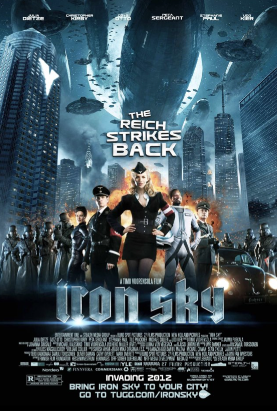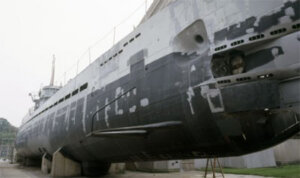
Unfortunately, the autograph line was full already and the exhibit was sold out, so we looked around the rest of the museum instead.
We stopped by to see the U-505 Submarine that has been on exhibit at the museum for as long as I can remember (I’m sure Jeff remembers it well). It occurred to me that there are probably not a lot of people in America who have seen a real German U-Boat. After some checking, it turns out that this is the only German U-Boat on display in all of North America.
Here is a little info and a few pictures of this piece of history. I highly recommend that if you ever come to Chicago, you stop by and visit the Museum of Science and Industry, there are a lot of amazing things there to see. You can take a tour of the inside of the U-Boat too, although today we just walked around the exhibit, listening to the story narrated by Bill Curtis.
This Information is courtesy of the Museum of Science and Industry website
On May 15, 1944, Task Group 22.3 sailed from Norfolk, Virginia for an antisubmarine patrol near the Canary Islands. For two weeks, Captain Dan Gallery and the six ships in the Task Group searched the area for a U-boat, assisted by daily location briefings transmitted from the F-21 submarine tracking room back in Washington, D.C.
The Task Group used all its technologies and determination to locate the target U-boat. Wildcat fighters from the USS Guadalcanal searched from the sky as sonar and hydrophone operators listened in the sea, but they couldn’t find the U-boat. A frustrated Gallery called off the search and began to head toward Casablanca for fuel.
On June 4, 1944 at 11:10am, the USS Chatelain reported a sonar contact and the Task Group jumped into action. The USS Guadalcanal could not attack without damaging itself so Captain Gallery moved the ship quickly out of harms way. Supported by the Destroyer Escorts USS Pillsbury and USS Jenks, the USS Chatelain swiftly attacked.
As the sonar crew maintained contact with the submerged U-505, the USS Chatelain attacked with a salvo of 24 hedgehogs that missed. While the USS Chatelain opened the range to turn and make another attack, two fighter planes 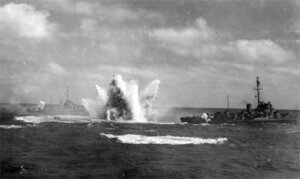
While the USS Chatelain and the USS Jenks picked up survivors, the USS Pillsbury sent its whaleboat to the U-505, where Lieutenant (junior grade) Albert L. David led a nine-man boarding party onto the sub. Despite the probability of the sub sinking or blowing up at any minute, and not knowing what form of resistance they might meet below, David and his men climbed down the hatch.
A quick examination proved the U-505 was deserted (except for one dead German sailor on deck, the only fatality of the capture). The boarders then set about disconnecting scuttle charges, closing valves and bundling up charts, codebooks and papers as quickly as possible.
U-boats were full of top-secret information and technology that Germany hoped would never fall into Allied hands. U-boat captains were under strict orders to scuttle (sink) their own subs if they were in danger of capture.
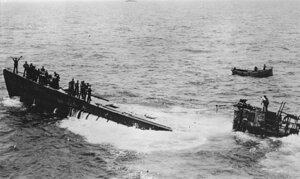
Before abandoning the U-505, the German crew was also trained to set the timers on numerous scuttle charges, or time bombs, located throughout the sub. The boarding and salvage parties quickly yanked the wires on the charges they discovered. If just one of the devices had detonated, it could have sent the U-boat and the American sailors to the bottom.
Capturing the U-505 was only part of the battle. Orders came in for Captain Daniel Gallery to tow the U-boat to Bermuda so the U.S. Navy could study her military secrets. The trip would cover 2,500 nautical miles — the longest tow of the war.
The lengthy voyage was not Gallery’s only challenge. He had a more pressing problem: the sub was in danger of sinking! The U-505 was full of seawater, her conning tower barely above the surface at times. To make matters worse, her rudder was stuck hard to starboard, making towing very difficult.
“When it was touch and go whether the sub would remain afloat, [Commander Earl Trosino] spent hours down in the bilges, crawling around in the oily water under the engines, tracing pipelines and closing valves to make the boat watertight. He risked his life many times by squirming into inaccessible corners under the floor plates where he wouldn’t have a chance to escape in case the sub started to sink. Thanks to Trosino’s uncanny instinct for finding the right valves, and his total disregard of his own safety, we succeeded in saving the U-505.”
– Captain Daniel Gallery, “We Captured a German Sub,”
The Saturday Evening Post, August 5, 1945
By the close of 1944, the Allies had a strong upper hand in the U-boat war. Still, it was not until May 4, 1945 that German Naval Command issued the following order: “Attention all U-boats. Cease-fire at once. Stop all hostile action against Allied shipping.” Three days later, Germany officially surrendered to the Allies.
With the U-boat threat eliminated, the U.S. Navy no longer needed to keep the U-505 a secret. A press release was issued on May 16, 1945, detailing the capture and salvage effort. In the months that followed, the U-505 went on tour as part of the U.S. government’s Seventh War Loan drive to raise funds for the war against Japan. The sub stopped at several East Coast cities, where spectators could climb aboard in exchange for purchasing war bonds.
By 1946, the Navy had extracted all the information and technology it needed from the U-505. With no reason to keep the sub, the Navy planned to use her for target practice. The story of the U-505 would have ended there were it not for Retired Admiral Daniel V. Gallery, the Museum of Science and Industry and the people of Chicago.
A Chicago native, Gallery was looking for a permanent home for the U-505 in his hometown. As luck would have it, the 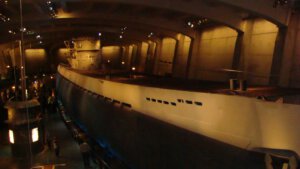
Like the capture and salvage efforts, bringing the U-505 to Chicago proved a monumental undertaking. On May 15, 1954, a tugboat began towing the sub from Portsmouth, New Hampshire, where she was being stored. The tow covered 3,000 miles — through 28 locks on the St. Lawrence Seaway, and through four of the five Great Lakes.
The U-505 arrived in Chicago on June 26, 1954, only to face another major hurdle: an 800-foot overland trip from Lake Michigan to the Museum. The task required extensive planning to cross Lake Shore Drive without destroying the pavement and tying up traffic. Engineers designed an elaborate rail and roller system to move the heavy sub out of the water and over the land. The City closed Lake Shore Drive the night of September 2, 1954 to allow the sub to cross. It took another week for the sub to complete its journey from the road to the Museum.
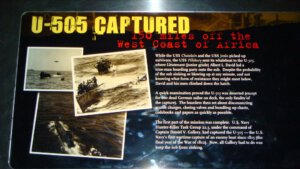
It is a fascinating piece of history, and you can see it at the Museum any time of the year. The sub has been moved indoors now, surrounded by a permanent exhibit with WWII movies, news reels, the story of the boat and its capture, over 200 artifacts from the boat, and a lot more.
The Museum also has a journey into a coal mine, a four story tornado simulator, the only dome shaped Omnimax theater in Chicagoland, and of course the Mythbusters Exhibit until September.
- A Dungeon Delve for Kids?: A Review of Dungeon! - Oct 24, 2022
- Better, Stronger, Faster | Descent: Journeys in the Dark Second Edition Reviewed - Oct 23, 2022
- Your Planet is Doomed!: Invasion from Outer Space Reviewed - Oct 22, 2022


